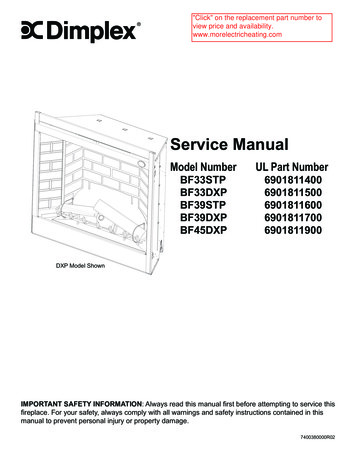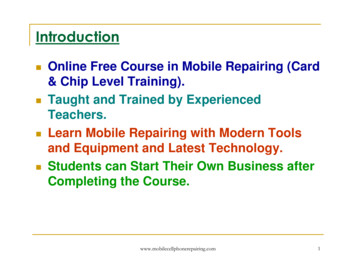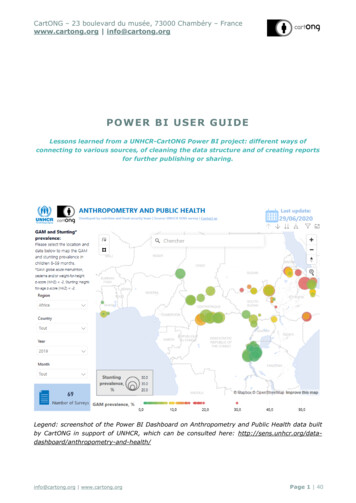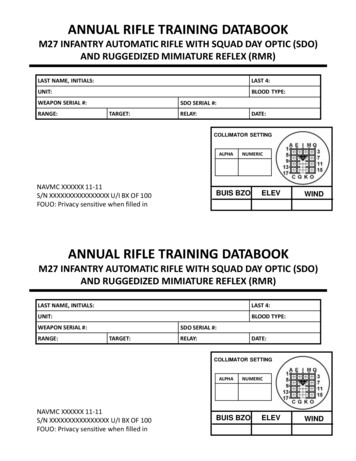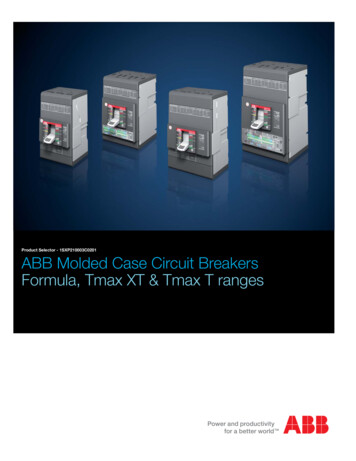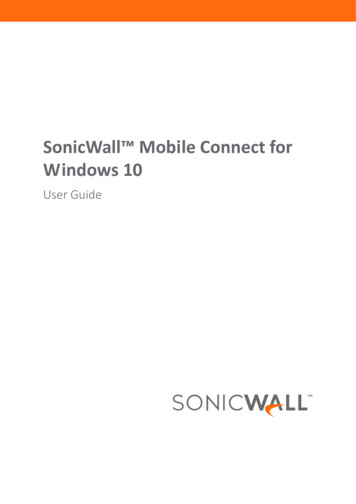
Transcription
MOBILE POWERProduct Selector Guidewww.maximintegrated.com/mobilepower
Table of ContentsIntroduction.3Power Management ICs (PMICs).3High-Performance Smartphone PMIC .4Single-Cell Power Supply for Wireless Hearables . 5Single-Cell Lithium-Ion Battery-OperatedSystems with Display.7Single-Cell Power Management for Portable MusicPlayers.8Smart Power Selector Convenient Charging .9Improve Boost Efficiency in BatteryApplications with Auto-Track. 29Increase Battery Life with True Shutdown. 30High-Efficiency Buck-Boost Regulator. 31LED Drivers. 34LED Driver Topologies.35Transmissive LCD LED Backlight Driver.36Single WLED Camera Flash Driver.37Battery Chargers and Fuel Gauges.11LED Ambient Temperature DeratingProtection.38Li Battery Charge Termination. 11Dual-Phase Step-Up Converter and LED Driver.39Single-Cell Battery Charger for HandheldGaming Devices . 12List of Figures. 41Linear vs. Switch-Mode Charging . 12Wireless Sensor Node Battery Charger. 13Single-Cell Digital Camera Battery Charger. 13Related Resources. 43Trademarks. 43List of TablesIntegrated Battery Charger and Fuel Gauge. 14Table 1. Power Management IC Product Selector. 10Single-Cell Wireless Speaker Charger and Fuel Gauge. 15Table 2. Battery Charger Product Selector. 16Fuel Gauges and the ModelGauge m5 Algorithm. 17Table 3. Fuel Gauges with SHA-256 Authentication. 19Featured Technology: EZ Config. 17Table 4. ModelGauge Fuel Gauge Product Selector.23MAX17055 High-Accuracy Fuel Gauge. 18Table 5. Buck Converter—Remote Sensingand Voltage Positioning Product Selector.32Counterfeit Battery Prevention withSHA-256 Fuel Gauge Authentication. 19Table 6. Boost Converter Product Selector.33Low-Power Fuel Gauge for Wireless Sensors. 21Table 7. Buck-Boost Converter Product Selector.33Multi-Cell Fuel Gauge for Robots and Drones.22Table 8. LED Driver Product Selector. 40DC-DC Converters.25Remote Sense Enhances Regulation andLoad Transient Response.26Voltage Positioning Increases LoadTransient Immunity.27USB Type-C Port Controller Power Supply. 28
Mobile Power Product Selector Guidewww.maximintegrated.comIntroductionThis edition of the Mobile Power Product Selector Guide highlightsour most popular power solutions for battery-powered devices.You’ll find insights to key features that enable longer battery life andreduced system size for mobile devices, including the advantagesthey deliver for battery-operated systems. Several applications arehighlighted to demonstrate the benefits of these features. At Maxim,we are committed to providing the technology you need to empowerdesign innovation for your mobile system designs.Power Management ICs (PMICs)mobile systems. PMIC solutions may include DC-DCconverters, LDOs, battery chargers, fuel gauges, LED driversand a variety of additional features that allow for monitoringand control of system performance. These highly integratedsolutions provide the high performance and small sizedemanded by mobile applications, all with high efficiencies tomaximize battery life.High-performance mobile devices employ a variety ofprocessors and/or FPGAs to perform target applications.These systems are typically battery-operated and requiremultiple low-voltage rails and protection. They may alsoinclude application-specific features. PMICs (Figure 1) offerhighly integrated solutions for modern O POWERCONTROL(SERIAL/IO)AUXILLARYPOWERFigure 1. Typical CPU Power Rails Provided by a PMICwww.maximintegrated.com/mobilepower3
Mobile Power Product Selector Guidewww.maximintegrated.comKey Features of MAX8660High-Performance Smartphone PMIC Configurable Power Performance– Four Step-Down DC-DC Converters– Four LDO Regulators– Adjustable Soft-Start Ramp-Rate– Power Sequencing– I2C Serial InterfaceSmartphones require multiple voltage rails that supportaggressive load transients to power high-end processors.High efficiency and small size are necessary characteristics forDC-DC converters in this application. The MAX8660 PMIC(Figure 2) supplies a total of eight voltage rails designedfor high-performance compact systems. Two dynamicallycontrolled step-down converters allow for in-system dynamicvoltage management (DVM) to optimize system performanceduring normal operation. Monitoring and control areprovided via I2C serial communication for effective softwaremanagement. Additional features include hardware ON/OFFoutput voltage control, low-battery indicator, and reset output.Altogether, these features provide a high-performance systemin a 40-pin TQFN package. Small Solution Size– 2MHz Switching Frequency Allows for Small Components– 40-Pin TQFN Package Extends Battery Life– 20μA Deep-Sleep Current– Automatic Switching Between FPWM and Light-LoadOperation Integrated Protection– Thermal Overload Protection– Input Under/Overvoltage Lockout– Internal Off-Discharge ResistorsI/OV1Li BATTERYV2HIGH-SPEEDMEMORYCPUMAX8660COREV4SRAMV8I2C CONTROLMCUV3V7BACKUPBATTERYI/O CONTROLV5V6USIM CARDREMOVABLESTORAGEAUDIOCODECFigure 2. Smartphone Block Diagram Using MAX8660 PMIC4www.maximintegrated.com/mobilepower
Mobile Power Product Selector Guidewww.maximintegrated.comSingle-Cell Power Supply for Wireless HearablesHearable devices have evolved from simple headsets(speakers and microphones) with wired analog connectorsto highly integrated audio systems capable of wirelesslytransmitting and receiving digital audio data. This evolutionhas allowed systems to eliminate the need for wired audioconnectors, such as the iconic 3.5mm jack, in favor of wirelesscommunication using Bluetooth . Additionally, an in-systemaudio digital signal processor (DSP) enhances the overalllistening experience, and is paired with captive speaker loadsthat enable efficient, low-noise amplifier technologies.Wireless hearable form-factors place size limitations on bothsystem design and battery selection, and thus small-scalePMICs are required to provide system power from a batterysource with high efficiency and low quiescent current.The MAX77650 SIMO buck-boost PMIC features lowquiescent power consumption and minimizes the solutionsize by efficiently providing a total of 3 DC outputs using asingle inductor. This compact PMIC provides the multiple railsthat are required by modern headphone applications utilizingboth tethered and untethered system architectures. Tetheredheadphones use a physical connection between the left andright speakers, while untethered headphones use a wirelesslink between the left and right speakers. Therefore, untetheredheadphones require independent supplies for both the rightand left speakers. Figures 3 and 4 demonstrate applicationsystems for wireless hearables using the MAX77650 PMIC,the MAX17048 fuel gauge and the MAX98090 low-powerhigh-performance CODEC. For size-constrained applications,the MAX9867 CODEC is recommended.LEGENDPOWER SUPPLYCONTROL DATABT RX/TXDIGITAL AUDIOANALOG AUDIOMCU(DSP)MAX98090MAX9867AUDIO CODECLEFTHPAMICS ORDMICSTETHERRIGHTHPMAX77650SIMO3.3μHFigure 3. Tethered Bluetooth Headset Application Using the MAX77650 SIMOwww.maximintegrated.com/mobilepower5
Mobile Power Product Selector GuideMCU(AUDIO GHTHPAMICS ORDMICSAUDIO CODECMAX98090MAX9867AMICS ORDMICSAUDIO CODECMCU(AUDIO DSP)NOTETHERBT T RX/TX3.3μHLEGENDPOWER SUPPLYCONTROL DATADIGITAL AUDIOANALOG AUDIOFigure 4. Untethered Bluetooth Headset Application Using MAX77650 SIMO6www.maximintegrated.com/mobilepower
Mobile Power Product Selector Guidewww.maximintegrated.comSingle-Cell Lithium-Ion Battery-Operated Systemswith DisplayKey Features of MAX8662 Two 95% Efficient Buck Regulators Four Low-Dropout Linear RegulatorsThe small size of battery-operated devices requires a highlevel of integration to fit all the required functions into thelimited space available. These systems typically requirebattery charging and several voltage rails. The MAX8662PMIC (Figure 5) provides seven voltage rails and a single-celllithium-ion (Li ) battery charger for small-scale portablesystems. The integrated battery charger uses proprietarySmart Power Selector technology to automatically distributepower between the source, battery, and system without theneed for external switches. Backlighting typically required bymobile displays is regulated using a 30mA white LED driverwith versatile PWM and analog dimming control. Integratedprotection features increase system reliability using only a fewexternal components.DC/USBINPUTPWR OKCHARGESTATUSCHARGEENABLEDCPOKCHG White LED Driver– 30mA (max)– PWM and Analog Dimming Control Adaptive Battery Charger– Smart Power Selector Integrated Protection– IC Thermal-Overload Protection– NTC Thermistor Input– Input Under/Overvoltage Lockout– Input Overcurrent ProtectionSYSBATMAX8662TO SYSTEMPOWERLi BATTERYOUT1LX10.98V TO VIN/1.2ACENEN1EN2OUT2LX20.98V TO VIN/0.9ALX3TO gure 5. MAX8662 Typical Operating Circuitwww.maximintegrated.com/mobilepower7
Mobile Power Product Selector Guidewww.maximintegrated.comSingle-Cell Power Management for Portable MusicPlayersPortable music players often include displays to providevisual feedback to the user. Many displays require lightingto enhance display brightness using an LED backlight. TheMAX8662 PMIC has an integrated LED driver to providebacklighting for small displays in portable applications.Additional rails include 2 buck converters for MCU or aBluetooth controller power supply and 4 LDOs for additionalsensors or peripheral functions. An integrated batterycharger with Smart Power Selector technology seamlesslydistributes power between the charger input, battery, andload. This reduces processor overhead and provides a standalone battery power solution for small handheld devicessuch as portable music players. The robust features of theMAX8662 are offered in a small 48-pin TQFN (37.2mm2package), which enables small form-factors for portable andhandheld applications. An example application circuit for aportable music player is shown in Figure 6 demonstrating theMAX8662 PMIC’s robustness.DISPLAY BACKLIGHTUSBADAPTERINPUTMAX8662Li BATTERYLDOsMAX98090CODECMAX17058FUEL GAUGEWi-Fi P*Contact us for information on multi-cell audio solutions.Figure 6. Portable Music Player Application Using MAX8662 PMIC8www.maximintegrated.com/mobilepower
Mobile Power Product Selector Guidewww.maximintegrated.comSmart Power Selector Convenient ChargingSmart Power Selector technology employs an internal chargepump supply and internal FETs to seamlessly distributepower between the external input, battery, and system load.Configuration is internally optimized and does not requireexternal components. Smart Power Selector technology isideal for frequently charged/discharged battery-operatedsystems, such as handheld devices.Basic Functions of Smart Power Selector Technology2. When the battery is connected and there is no external powerinput, the system is powered from the battery (Figure 9).SYSSYSTEMLOADQ2BATTERY-TO-SYSSWITCH(DISCHARGE PATH)BATBATTERY1. With both the external power supply and battery connected.a) When the system load requirements exceed the capacityof the external power input (Figure 7), the battery suppliessupplemental current to the load.AC ADAPTERORUSB INPUTDCGNDMAX8662MAX8663RTHMTHMFigure 9. Power Path With Battery, But No External SupplyQ1 TCH(DISCHARGE PATH)BATBATTERY3) When an external power input is connected and there is nobattery, the system is powered from the external power input(Figure 10).AC ADAPTERORUSB Figure 7. Power Path When ILOAD IDCb) When the system load requirements are less than thecapacity of the external power input (Figure 8), the battery ischarged with residual power from the input.AC ADAPTERORUSB INPUTDCQ1 INPUT-TO-SYSSWITCHMAX8662MAX8663Figure 10. Power Path With External Supply, But No 8662MAX8663THMRTHMFigure 8. Power Path When ILOAD IDCwww.maximintegrated.com/mobilepower9
Mobile Power Product Selector Guidewww.maximintegrated.comTable 1. Power Management IC Product SelectorPartNumberPrimary TopologyNumber ofOutputsLCD/LED/Flash/CCDGPIO FeaturesMax. IOUT lablePackage(max with pins)(mm2)0.725 to 3.31.62000TQFN/4026VIN Range(V)VOUT Range(V)2.6 to 6MAX8660Step-downMAX8662Step-downWhite LED2.6 to 81 to 3.31.21000TQFN/4837.2MAX8819Step-downWhite LED4.1 to 5.51 to 5.30.51000, 2000TQFN/2816.8MAX77812Step-down1-42 GPIO2.5 to 5.50.25 to 1.525202000WLP/6411.5MAX77874Step-down1nIRQ, DVS2.7 to 4.80.25 to 1.3162000WLP/486.5MAX77503Step-down1POK3 to 140.8 to99%Vin1.51000WLP/122.6MAX77324Step-down12.5 to 4.80.6 to 21.52000 nominalWLP/61.0MAX77756Step-down13 to 241 to 99%Vin0.51000WLP/153.3MAX77596Step-down13.5 to 241 to 100.31700TDFN/1054.1 to 7.250.8 to 5.250.3Up to 3000WLP/305.92.7 to 5.50.8 to 4.60.8 to 5.1750.3Up to 3000WLP/1632POKSINGLE-INDUCTOR X77278SIMOH-BridgeStep-Up/Down1-48 GPIOs2.8 to 5.50.85 to 5.50.3Up to 3000WLP/356.8SIMOH-BridgeStep-Up/Down1-41 GPIO2.7 to 5.50.8 to 3.950.8 to 5.250.3Up to 3000WLP/305.9SIMOH-BridgeStep-Up/Down1-32.7 to 5.50.8 to 1.58752.4 to 5.250.3Up to 3000WLP/305.9MAX77640MAX77680MAX7768110LED sink1 GPIOwww.maximintegrated.com/mobilepower
Mobile Power Product Selector GuideBattery Chargers and Fuel GaugesMobile devices require high-capacity rechargeable batteriesto provide system power. These systems typically use Li batteries due to their light weight and high energy density.Our battery chargers offer a variety of features, which enableaccurate and robust designs to ensure safe battery-chargingsolutions. Our fuel gauges monitor remaining battery chargeusing a proprietary ModelGauge algorithm to provide highaccuracy. In addition, they offer SHA-256 authentication toprevent battery pack cloning. Together, our battery chargersand fuel gauges (Figure 11) provide the efficiency, accuracy, andprotection required to support Li battery applications.www.maximintegrated.comtermination method. Our battery chargers offer a broad range offast-charge termination methods to suit your design needs.In the top-off stage, the remaining battery capacity ischarged with constant voltage. The top-off charging currentis terminated based on a timer, which begins count at thebeginning of the top-off stage. This stage maximizes capacity todeliver the most from your battery.Charge Control MethodsFast-charging is complete once the requirement of primarytermination is met. Primary termination comes in a variety ofapproaches that are battery chemistry dependent. Below is alist of fast-charge termination methods compatible with Li batteries.Li Battery Charge TerminationFast-charging requires high current to quickly charge thebattery. Charge current is determined by the battery capacityand required charge time; however, battery manufacturerswill specify a maximum charge current. The maximumcharge current limits the time in which the battery may besafely charged. The fast-charging phase ends with a OFFBATTERY VOLTAGEVPLTHTIMEIFCHGBATTERY CHARGE CURRENTIn the case of severely depleted Li batteries, a large currentmay potentially cause damage to the battery. Prequalificationmeasures and determines an acceptable battery voltage toallow safe charging. The battery is charged using a low currentuntil the voltage rises above a specified limit. Once the batteryis at a safe voltage level, fast-charging begins.VBATREGIPQ0Proper charge termination is imperative to all rechargeablebattery-operated devices for extended battery life. Moreover,Li batteries require specialized care to avoid disastrous effectsdue to improper charging. Our Li chargers incorporate threecharging stages to accommodate safe charging. These chargingstages include prequalification, fast-charge, and top-off(Figure 12). However, additional stages may be included toincrease battery protection and performance.FAST-CHARGE(CONSTANT VOLTAGE)Figure 11. Li Battery Charging and Fuel GaugingFAST-CHARGE(CONSTANT CURRENT)PREQUALIFICATIONCurrent Limit — Sets a maximum charging current limit.Charger remains in constant current (CC) mode at thespecified limit until either a maximum voltage is detected,and/or a timer expires. Both maximum voltage and timer areadjustable limits, and thus provide design flexibility.TIMEFigure 12. Charging Stages for Safe Charging11
Mobile Power Product Selector Guidewww.maximintegrated.comSingle-Cell Battery Charger for Handheld Gaming DevicesLimits are adjustable either through hardware or I2C/SMBus. This method offers fast charging and flexibility in anintegrated package.The fast-growing video game industry continually develops newproducts with increasingly smaller form-factors while addingmore features to enhance user experience. Handheld gamingdevices require large batteries to support video processing,real-time motion sensing, wireless communication, andperipheral sensors. This entails a battery charger that mustsupply a high fast-charge current to quickly charge the battery,while maintaining a small solution size. The MAX8971 candeliver up to 1.55A of fast-charge current and is available ina 2.18mm x 1.62mm WLP package. A safeout LDO providespower to 5V low-power USB PHY. This battery charger IC isJEITA-compliant, which provides safe charging over a widetemperature range. In addition, the device supports a GSM testmode that provides a 2.3A peak pulse current at 217Hz with a12.5% on-duty cycle. This test mode allows the manufacturerto test battery performance with transient loads expected fromGSM transceivers. This enhances reliability for gaming deviceswith location and/or data services. Figure 13 is an exampleapplication circuit demonstrating the use of the MAX8971 in atypical handheld gaming system.Minimum Charge Current — The charger initially providesa fixed constant current. Charge current is reduced as thebattery approaches maximum voltage. Charging ends once aspecified minimum charge current is reached.External Control — These devices typically have aninput to control charge current. This allows designers toimplement proprietary charging algorithms using an externalmicrocontroller. These devices offer simplicity and flexibilityin a wide variety of applications with a simple microcontroller.Smart Battery Control — A smart battery has integratedbattery management, which communicates chargingspecifications with a smart charger using SMBus. Chargingfollows guidelines set by the Smart Battery ChargerSpecification Revision 1.1.Timer — Charging terminates based on an expired timercount. Timer begins count when the charging phase isenabled. This method is also used as protection to preventrunaway charging current.Linear vs. Switch-Mode ChargingMaximum Temperature — Charging terminates based onbattery temperature. A set thermal limit prevents batteryoverheating, which provides battery protection. This methodrequires a local battery thermistor to accurately detectbattery temperature.Battery chargers come in a variety of topologies, eachoptimized for specific design goals. Mobile applicationsrequire low battery voltages; thus, battery chargers arenormally step-down devices. Two of the most commonbattery-charging solutions use either linear or switchingtopologies to regulate charge current.GSM Wi-Fi 971THMLi BATTERY MAX98090AUDIO CODECMAX17260FUEL GAUGECS CS-HAPTIC ACTUATORSRSENSE5V USBPHYSFOMAX98357AVLSDA/SCLMICI2C CONTROLMCUFPGA/PROCESSORAUDIO AMPLIFIER/HAPTIC DRIVER*Contact us for information on multi-cell audio solutions.Figure 13. Typical Handheld Gaming System Using MAX8971 Battery Charger12www.maximintegrated.com/mobilepower
Mobile Power Product Selector GuideL inear chargers adjust the resistance across a high-side FETto regulate charging current to a battery load. Switch-modechargers employ a buck topology, which regulates chargingcurrent by adjusting the duty cycle and/or frequency of aPWM power signal. The PWM power signal is then filtered toachieve the desired charge current.Benefits of Linear Charging Low-Cost– Reduced Component Count– No Magnetic Components Small Size– Only Input/Output Capacitors– No Filtering Requiredwww.maximintegrated.comWireless Sensor Node Battery ChargerLinear battery chargers are a great fit in small systems withlow battery capacities such as wireless sensor nodes. Theselow battery capacity systems require little charge current.The low IQ of linear battery chargers enable longer batterylife. Figure 14 demonstrates a typical application circuit for awireless sensor node using the MAX8814 linear charger setfor 500mA of fast charge current.MAX17048FUEL GAUGEUSB ADAPTERINPUTINBATTMAX8814GND Reduced EMI– No Switching NoiseLi 15.8kΩBenefits of Switch-Mode Charging Maximum Charging Current 1A– Limited by AC and DC Characteristics of InternalSwitching FETs Wide Input Voltage Range– Limited by Duty Cycle Greater Efficiency– Low Power Dissipation– Less Thermal GenerationFigure 14. Wireless Sensor Node Using MAX8814 Linear Battery ChargerSingle-Cell Digital Camera Battery ChargerFor applications with large battery capacities, greater chargecurrent is required. Switch-mode chargers are ideal for theseapplications due to high efficiency at higher charge currents.Handheld cameras need large batteries to support videoprocessing and encoding. This will require a larger chargingcurrent to quickly charge the battery. The MAX8903 highefficiency charger provides up to 2A fast-charge current.A 4MHz switching frequency reduces inductor sizing andoverall system size. The dual input allows the user to chargethe camera from either an AC adapter or USB input. Figure 15demonstrates battery charging in a digital camera application.WLEDDRIVERADAPTERPOWER(4.15 TO 16V)SPEAKERMAX98090CODECDCSYSMAX8903USB POWER(5V)MICORMAX98357DIGITALAMPLIFIERUSBSPEAKER2A FAST CHARGEBATTLi BATTERYMAX17260I/O CONTROLFUEL GAUGECS MCUCS-RSENSE*Contact us for information on multi-cell audio solutions.Figure 15. Digital Camera Application Using the MAX8903Switch-Mode Chargerwww.maximintegrated.com/mobilepower13
Mobile Power Product Selector Guidewww.maximintegrated.comIntegrated Battery Charger and Fuel GaugeKey Features of MAX77818 Dynamic Charging Capabilities– 3A Switch-Mode Charger– Adapter/USB Input– Wireless Charging Input– Smart Power SelectorEver-shrinking mobile systems require small solutions with ahigh level of integration. The MAX77818 (Figure 16) integratesboth a battery charger and fuel gauge to deliver the most frombattery-operated applications with system configurabilitythrough an I2C serial interface. The battery charger integrateslow-loss switches that operate at a 4MHz switching frequencyto reduce size. A ModelGauge m5 fuel gauge also provides highaccuracy and additional configurability to extend battery life.The charger is re-purposed to support USB On-The-Go (OTG)up to 5.1V at 1.5A using reverse boost capabilities. Altogether,the MAX77818 is a great fit for battery-operated mobilesystems where small size and system integration is required.VUSB/VADPCHGIN Integrated Protection– Under/Overvoltage Lockout– Adjustable OCP– Charge Safety Timer– Die Temp Monitor with Thermal FoldbackMAX77818CHGINBYPBST 3.2V TO 14V OPERATINGUP TO 4.0A INPUT CURRENTWIRELESSWCIN ModelGauge m5 Battery Fuel Gauge– 1% State-of-Charge Accuracy– No Calibration Cycles– Time-to-Empty and Time-to-Full PredictionVBYP5.05V(REVERSE BOOST MODE)CHGIN INPUT CURRENTLIMIT SWITCHBUCK/BOOSTCONTROLLERWCINAVLWCIN INPUT CURRENTLIMIT AND 5.9VOVERVOLTAGE SWITCHCHGLXVSYSCHGPGNDSYSPVLCHARGE ANDSMARTPOWER PATHCONTROLLERREVERSEBLOCKINGBATTUP TO 3.0ACHARGE CURRENTFigure 16. MAX77818 Typical Operating Circuit14www.maximintegrated.com/mobilepower
Mobile Power Product Selector Guidewww.maximintegrated.comSingle-Cell Wireless Speaker Charger and Fuel GaugeWireless speakers allow us to hear music without beingbound to a wall outlet. This modern invention has grown incomplexity to include features such as artificial intelligence.These features require larger batteries with greater capacityto support the power demanded by power-hungry processors.It becomes necessary to provide larger charging current tocharge the battery within a reasonable time. However, it is alsoimportant to keep a small solution size to minimize overallsystem size. The MAX77818 (Figure 17) is a switch-modecharger that delivers 3A of fast-charge current in a small3.87mm x 3.61mm WLP package. Dual-charging inputs allowthe user to charge the device from either an adapter or from awireless charging input. The adapter input offers reverse boostcapabilities and may be used to power USB-OTG devices.To add another level of integration, an internal ModelGaugem5 fuel gauge keeps track of the state-of-charge (SOC) to1% accuracy and offers both time-to-empty and time-tofull predictions. These features enhance wireless speakerperformance by providing feedback and additional features tothe C CONTROLFPGA/PROCESSORMICMCUBATTLi BATTERYLEGENDPOWER SUPPLYMAX98357DIGITALAMPLIFIERORSPEAKERCONTROL DATADIGITAL AUDIOANALOG AUDIOMAX98304AUDIOAMPLIFIER*Contact us for information on multi-cell audio solutions.Figure 17. Wireless Speaker Application Using MAX77818 Battery Charger and Fuel Gaugewww.maximintegrated.com/mobilepower15
Mobile Power Product Selector Guidewww.maximintegrated.comTable 2. Battery Chargers Product SelectorPartNumberCell ChemistryProtectedVIN (max)(V)ChargerVoltage (V)Charge RateSet ByMax.ICHG (A)Key th pins)(mm2)SWITCH-MODE CHARGERSMAX778601-cell Li 164.2 to 4.41(12.5mV steps)I2C/SMBus3.15Power path, USB-C CC and BC1.2 detectionWLP/8115.3MAX778181-cell Li 163.625 to 4.7(25mV Steps)I2C/SMBus3Dual input, power path, ModelGauge m5fuel gaugeWLP/7214.0MAX89031-cell Li 204.1, 4.15, 4.2,4.35Preset, resistor2Standalone, firmware-free, power pathTQFN/2816.8MAX89711-cell Li 224.1, 4.15, 4.2,4.35I 2C/SMBus1.55High voltage, JEITA compliantWLP/203.5—203.5 to 12.7(100mVsteps)I2C/SMBus1.5Wireless receiver for WPC(Qi) �DS27121/2-cell NiMH5.5—Resistor—Standalone, firmware-free, thermistor,timerSOIC(N)/16TSSOP/1633.4DS27101-cell NiMH5.5—Resistor—Standalone, firmware-free, thermistorTDFN/1011.3MAX77950Standalone, firmware-free, switch mode orSOIC(N)/16linear charge controller61.9LINEAR CHARGERSMAX88951-cell Li 164.2External source,Resistor1.85Standalone, firmware-free, power path,USB BC1.1 detectionWLP/257.9MAX15011-cell Li , 3-cellNiMH144.1, 4.2,4.5, 4.95Resistor1.4Standalone, firmware-free, multi-chemistry, temperature-regulated chargingTQFN/1626MAX89341-cell Li 164.075, 4.2Logic input,resistor1.5Standalone, firmware-free, dual input,power path, JEITA compliantTQFN/2816.8MAX86771-cell Li 164.2Logic input,resistor1.5Standalone, firmware-free, dual input,power pathTQFN/2416.8MAX86061-cell Li 164.2Logic input,resistor1Standalone, firmware-free, power path,timerTDFN-EP/149.6MAX88561-cell Li 164.2Logic input,reset, resistor1Standalone, firmware-free, power pathTDFN-EP/149.6MAX88081-cell Li 164.2Resistor1Standalone, firmware-free, temperatureregulationTDFN-EP/84.2MAX773011-cell Li 164.1, 4.15,4.2, 4.05I2C/SMBus0.9Power path, USB BC1.1 detection, JEITAcompliantWLP/256.0MAX77950—203.5 to 12.7(100mV steps)I2C/SMBus1.5Wireless receiver for WPC(Qi) /PMAWLP/549.9DS2715Multi-cell NiMH18—Resistor—Standalone, firmware-free, switch-mode,or linear charge controllerSOIC(N)/1661.9DS27111/2-cell NiMH6—Resistor—Standalone, .416www.maximintegrated.com/mobilepower
Mobile Power Product Selector GuideFuel Gauges and the ModelGauge m5 AlgorithmMobile systems require high-accuracy fuel gauging to estimateremaining capacity and maximize bat
(speakers and microphones) with wired analog connectors to highly integrated audio systems capable of wirelessly transmitting and receiving digital audio data. This evolution has allowed systems to eliminate the need for wired audio connectors, such as the iconic 3.5mm jack, in favor of wireless communication using Bluetooth .
